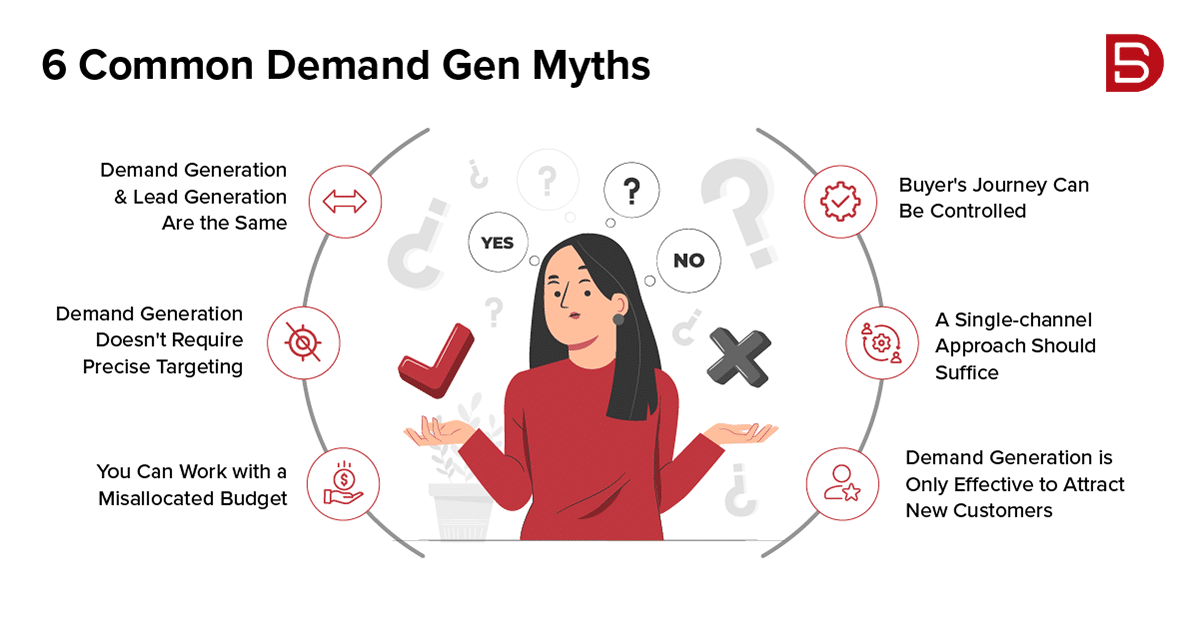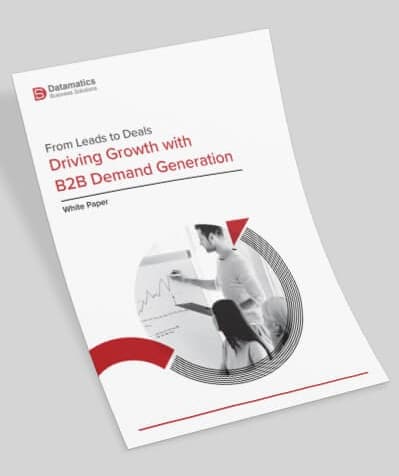Executing demand-generation campaigns with a flawed strategy is similar to building a house on shaky ground – a recipe for disaster. If your strategy is plagued with misconceptions and myths, you may fall short of your goals.
B2B marketers grapple with a multitude of myths and assumptions. With the ever-changing marketing landscape, it’s no cakewalk to separate fact from fiction. Plus, it’s a time-consuming task to figure out whether the demand generation process you have in place is the real deal or just smoke and mirrors.
Time is a precious resource for marketers, and it’s crucial to make the most of it. To succeed, you need to focus on achieving maximum results within a limited timeframe. Many of the methods used in the demand generation process today are rooted in outdated approaches, and B2B marketers must leverage the latest demand generation trends to keep pace with the evolving landscape. To save you time and trouble, we’ve pinpointed six myths that can be dispelled to craft an effective demand-generation process. So, let’s get started.
Cracking the Demand Generation Code: Debunking 6 Common Myths
Myth 1: Demand Generation & Lead Generation Are the Same
There’s a common misconception among marketers that demand generation and lead generation are the same. In fact, a Google search for specific demand generation keywords may yield results related to lead generation, which only adds to the confusion.
However, it’s crucial to recognize that these two strategies have distinct purposes. While lead generation focuses on collecting contact information from interested individuals, the demand generation strategy has a broader scope. Its main goal is creating awareness and stimulating interest in contemporary products and services.
While some marketers often blur the lines between these two methods, it’s important to grasp that demand generation is a significantly more intricate and strategic approach. Instead of merely focusing on filling out forms, demand generation employs tactics to educate consumers and spark a genuine need or desire for what marketers have to offer. The idea is to educate your customers, and eventually, leads will naturally gravitate toward your offering. So, if you’re looking to take your marketing efforts to the next level, consider working with a demand generation services provider to maximize your reach and impact.
Myth 2: Demand Generation Doesn't Require Precise Targeting
Many people may think that demand generation doesn’t require precise targeting because its primary goal is to boost brand awareness. While reach is important for branding, it’s not the sole factor to consider.
The demand generation process is more intricate than that. Without targeting the right audience, you’re likely to see minimal results. For instance, showing TV commercials to people looking for refrigerators won’t be effective. To truly provide value through your marketing, it’s essential to offer something relevant and tailor your communications to meet your audience’s needs. In today’s marketing landscape, customers expect a personalized experience and have little patience for irrelevant content. When developing demand-generation strategies, marketers must carefully consider the buyer’s journey.
Myth 3: You Can Work with a Misallocated Budget
It’s no secret that businesses have their preferred methods for demand generation and marketing. There are several reasons for this, including:
- Past successes with specific marketing approaches.
- A tendency to stick with what’s familiar rather than assessing new tactics.
- Using inadequate or incorrect demand generation metrics to measure marketing performance, which leads to hasty decisions.
Because of these tendencies, you often see businesses pouring a lot of resources into some areas while ignoring other potentially valuable marketing channels. This is a trap that even experienced marketing executives can fall into.
The very sophisticated nature of today’s consumers, particularly in the B2B sector, frequently necessitates using many platforms for outreach efforts. To spark demand, you’ve got to communicate with your prospects in ways that match how they like getting their information.
Myth 4: Buyer's Journey Can Be Controlled
Many marketers are well aware that in today’s buyer’s journey, the sales team often enters the picture at a later stage. Statistics from Gartner and Forrester indicate that more than 75% of the purchasing process now happens online. Consumers have a significant influence at every step of this process. Yet, as marketers, our main focus often revolves around managing the buying journey by creating and dismantling sales funnels. The assumption is that consumers can conduct their research and if they reach out, they can be guided by sales or marketing experts.
However, this is where many customers can go astray online. They have the freedom to explore your content or simply ignore it without a compelling reason. They can browse customer reviews, including those who weren’t entirely satisfied with your products or services, on online forums, communities, and e-commerce platforms. In the digital age, transparency is the norm, and you can’t fully control your customers’ online behavior. Their perspective is now shaped by what they choose to read and see, not just what you tell them.
The best you can do is be prepared for any scenario. Utilize your CRM to generate content tailored to each stage of the buyer’s journey. If potential customers want to assess your offerings at any point, you can provide them with informative and relevant content.
Myth 5- A Single-channel Approach Should Suffice
Back in the days before digital technology took over, people used to think that a single marketing channel was all you needed to create demand. But as digitalization gained traction, B2B marketers realized the power of using multiple channels in their campaigns to boost demand and get the results they wanted.
Studies have shown that when companies adopt a two- or multi-channel approach to engage consumers, they often see engagement levels shoot up by about four times on average. This data proves that a multi-channel B2B demand generation framework not only boosts sales but also keeps prospects engaged throughout the entire sales process.
Myth 6- Demand Generation is Only Effective to Attract New Customers
The demand generation process is closely tied to kicking off the sales cycle because it involves spreading awareness about your products or services. It’s that initial phase when you make your first introduction to potential customers.
But demand generation isn’t limited to just the top-of-the-funnel. It can extend throughout the entire sales funnel, even retaining existing customers. Activities like hosting events, webinars, and other initiatives are great examples of efforts that generate content for the middle stage of the funnel, which can be valuable for ongoing demand development.
Conclusion
In a nutshell, creating content that caters to the user’s needs and preferences can make a significant impact. The real secret here is truly understanding what your customers like. When it comes to marketing, what works like magic for one organization might not do the same for another. What you believe to be untrue could be a game-changer for someone else. It’s a process of trial and error.
To figure out which strategies suit your unique situation, you need to experiment with various approaches. Sometimes, strategies you were confident in may not deliver the expected results, while those you had doubts about could surprise you with outstanding outcomes. That’s the nature of marketing – challenging your assumptions, optimizing your time, and making the most of your resources to craft an effective demand generation strategy. If you’re ready to step up your demand generation game, write to us at marketing@datamaticsbpm.com. We can help you navigate this dynamic landscape and tailor strategies that perfectly fit your business.
 Select an element to maximize. Press ESC to cancel.
Select an element to maximize. Press ESC to cancel.
Courtney McCombs




